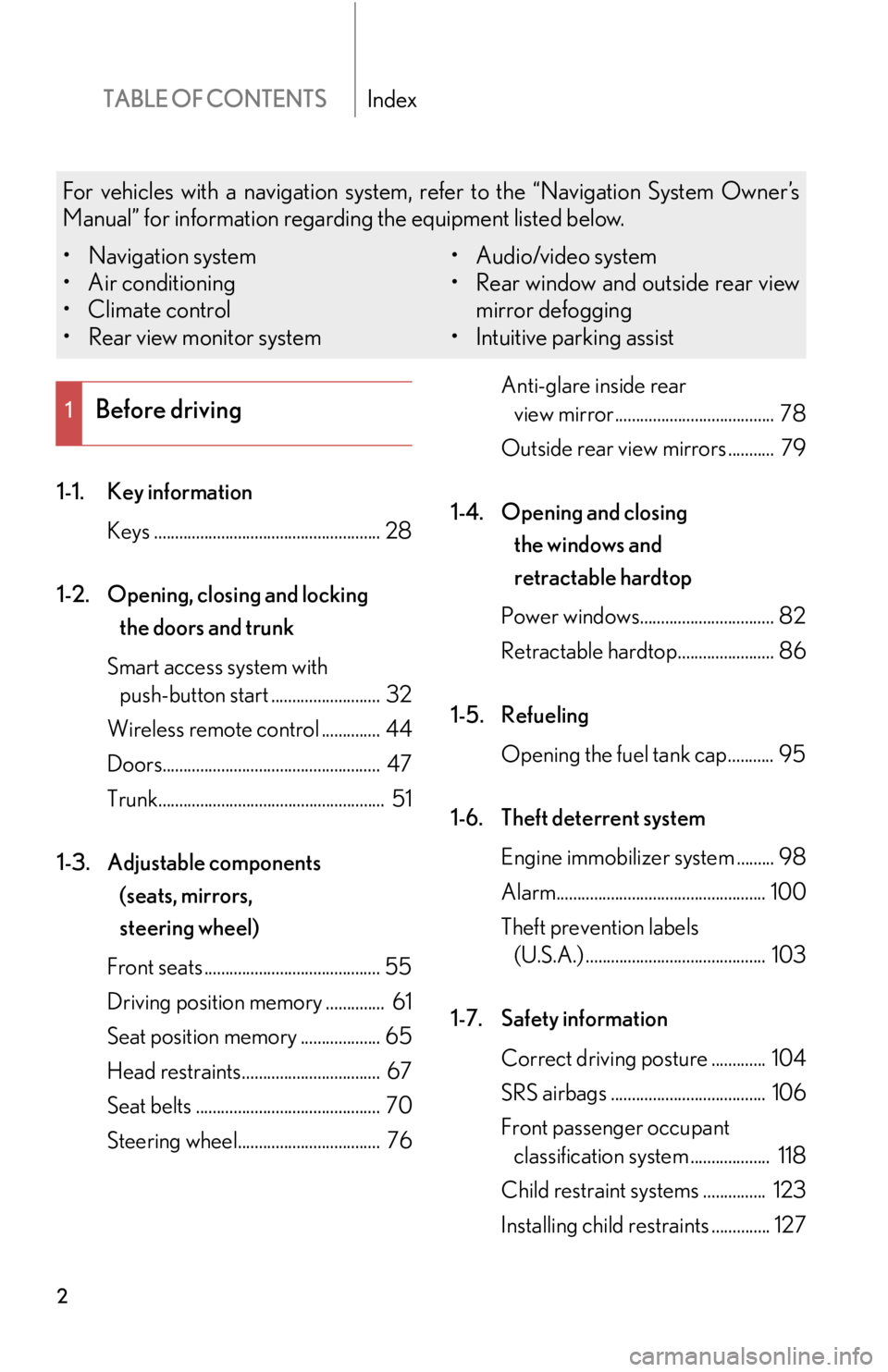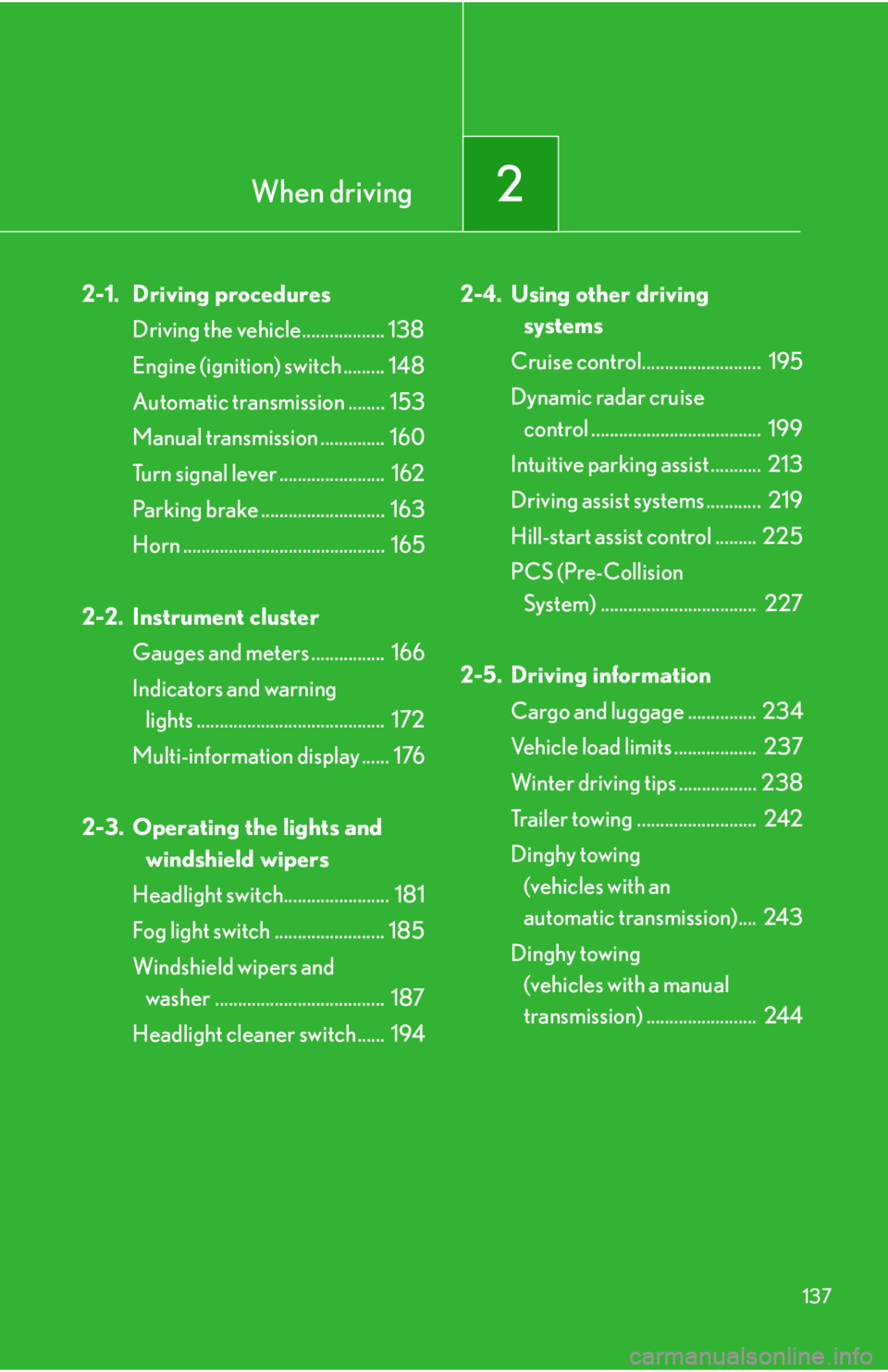park assist Lexus IS250C 2012 Instrument cluster / LEXUS 2012 IS250C,IS350C OWNERS MANUAL (OM53A62U)
[x] Cancel search | Manufacturer: LEXUS, Model Year: 2012, Model line: IS250C, Model: Lexus IS250C 2012Pages: 632, PDF Size: 6.77 MB
Page 2 of 632

TABLE OF CONTENTSIndex
2
1-1. Key informationKeys ...................................................... 28
1-2. Opening, closing and locking the doors and trunk
Smart access system with push-button start .......................... 32
Wireless remote control .............. 44
Doors.................................................... 47
Trunk...................................................... 51
1-3. Adjustable components (seats, mirrors,
steering wheel)
Front seats .......................................... 55
Driving position memory .............. 61
Seat position memory ................... 65
Head restraints................................. 67
Seat belts ............................................ 70
Steering wheel.................................. 76 Anti-glare inside rear
view mirror...................................... 78
Outside rear view mirrors ........... 79
1-4. Opening and closing the windows and
retractable hardtop
Power windows................................ 82
Retractable hardtop....................... 86
1-5. Refueling Opening the fuel tank cap........... 95
1-6. Theft deterrent system Engine immobilizer system ......... 98
Alarm.................................................. 100
Theft prevention labels (U.S.A.) ........................................... 103
1-7. Safety information Correct driving posture ............. 104
SRS airbags ..................................... 106
Front passenger occupant classification system ................... 118
Child restraint sy stems ............... 123
Installing child restraints .............. 127
1Before driving
For vehicles with a navigation system, refer to the “Navigation System Owner’s
Manual” for information regarding the equipment listed below.
• Navigation system
• Air conditioning
• Climate control
• Rear view monitor system • Audio/video system
• Rear window and outside rear view
mirror defogging
• Intuitive parking assist
Page 3 of 632

1
2
3
4
5
6
7
3
2-1. Driving proceduresDriving the vehicle ........................ 138
Engine (ignition) switch .............. 148
Automatic transmission.............. 153
Manual transmission .................... 160
Turn signal lever ............................ 162
Parking brake ................................. 163
Horn.................................................... 165
2-2. Instrument cluster Gauges and meters ..................... 166
Indicators and warning lights.................................................. 172
Multi-information display........... 176
2-3. Operating the lights and windshield wipers
Headlight switch ............................. 181
Fog light switch .............................. 185
Windshield wipers and washer............................................. 187
Headlight cleaner switch ........... 194 2-4. Using other driving systems
Cruise control ................................ 195
Dynamic radar cruise control............................................. 199
Intuitive parking assist ................. 213
Driving assist systems.................. 219
Hill-start assist control ............... 225
PCS (Pre-Collision System).... 227
2-5. Driving information Cargo and luggage ..................... 234
Vehicle load limits ........................ 237
Winter driving tips ....................... 238
Trailer towing ................................. 242
Dinghy towing (vehicles with an automatic
transmission) ............................... 243
Dinghy towing (vehicles with a manual
transmission) ............................... 244
2When driving
Page 90 of 632

90
1-4. Opening and closing the windows and retractable hardtop
Retractable hardtop operation control linked to the intuitive parking
assist (vehicles with an intuitive parking assist)
This function detects if there is an ob struction behind the vehicle and reg-
ulates retractable hardtop operation according to the vehicle’s distance
from that obstruction.
This function is merely de signed to assist the driver and is not a guarantee
of the safety of the ar ea behind the vehicle. The driver should always
check the vehicle’s surroundings with their own eyes before operating the
retractable hardtop.
■ Operation controls according to each detection area
Area within approximately
1.2 ft. (35 cm) of the vehicle
Area approximately
1.2 ft. (35 cm) to 1.5 ft. (45 cm)
away from the vehicle
Areas within approximately
0.8 ft. (25 cm) of the vehicle
Areas approximately
0.8 ft. (25 cm) to
1.3 ft. (37.5 cm) away from the
vehicle
This function only operates in the
areas indicated in the illustration.
Therefore, obstructions too close
to the sensors cannot be detected.
●If an obstruction is d etected in area or when the switch is oper-
ated
A buzzer will sound and a message will be shown in the multi-informa-
tion display to alert the driver.
If the switch is held up or down for 3 seconds while the message is being dis-
played, retractable hardtop operation will start normally.
Page 91 of 632

91
1-4. Opening and closing the windows and retractable hardtop
1
Before driving
●If an obstruction is d etected in area or when the switch is oper-
ated
A buzzer will sound twice and a messa ge will be shown in the multi-
information display. Retractable hardtop operation will not activate.
If the switch is released and then oper ated again within 2 seconds, the buzzer
will sound again and a message will be sh own in the multi-information display
to alert the driver. If the switch is he ld up or down for 3 seconds, retractable
hardtop operation will start normally.
If an obstruction is detected in area or while the trunk lid is operat-
ing, a buzzer will sound twice and a message will be shown in the multi-
information display. Retractable hard top operation will be suspended for
safety reasons.
Ensure that no obstructions are near the vehicle and then operate the
switch again.
■Operating conditions
●The vehicle is stopped.
●The engine is running. (Operation while the engine is not running is possible if
the “ENGINE START STOP” switch is in IGNITION ON mode, but for optimal
operation the engine should be running.)
●The trunk lid is closed.
●The trunk opener main switch is on. ( P. 5 1 )
●The luggage cover in the trunk is properly set. ( P. 8 7 )
When the vehicle is on an incline or an uneven surface, the retractable hardtop may
not activate properly.
If the intuitive parking assist detect an obstruction behind the vehicle, the retract-
able hardtop may not operate.
■Switch operation when the operating conditions are not met
Even if all of the operating conditions are not met, when the switch is operated with
the vehicle stopped and the retractable hardtop fully closed, the following opera-
tions can be performed:
●Holding the switch up closes all the side windows.
●Holding the switch down op ens all the side windows.
Page 92 of 632

92
1-4. Opening and closing the windows and retractable hardtop
■When a message appears and the retractable hardtop does not operate
Check the message contents and perform the recommended procedure, then
operate the switch again. (P. 5 0 7 )
■Retractable hardtop operation control linked to the intuitive parking assist
●This function will activate when th e intuitive parking assist is on. (P. 3 7 1 )
●Once the trunk lid has been fully opened, this function will be disabled.
●The trunk lid can be closed even when an obstruction is detected by operating
the retractable hardtop operation sw itch in the opposite direction.
■If the intuitive parking assist is dirty or malfunctioning
If a message is shown in the multi-information display indicating that a sensor is mal-
functioning or needs to be cleaned, th e retractable hardtop cannot be operated
normally. To start retractable hardtop operation, turn the intuitive parking assist off
and operate the switch for the retractable hardtop again, or hold the switch up or
down for 6 seconds or more. In this case, retractable hardtop operation control
linked to the intuitive parking assist-sensor will not function.
■Customization that can be configured at a Lexus dealer
Setting of the intuitive parking assist linked function can be changed.
(Customizable features P. 5 9 5 )
Page 109 of 632

109
1-7. Safety information
1
Before driving
■SRS warning light
This warning light system monitors the airbag sensor assembly, front airbag sensors,
side airbag sensor assemblies , driver's seat position sensor, driver's seat belt buckle
switch, seat belt pretensioner assemblies, inflators, interconnecting wiring and
power sources. ( P. 4 9 6 )
■If the SRS airbags deploy (inflate)
●Bruising and slight abrasions may result from contact with a deploying (inflating)
SRS airbag.
●A loud noise and white powder will be emitted.
●Parts of the airbag module (steering wheel , airbag cover and inflator) as well as
the front seats may be hot for several minu tes. The airbag itself may also be hot.
●The windshield may crack.
●For Safety Connect subscribers, if the SRS airbags deploy or in the event of a
severe rear-end collision, the system is designed to send an emergency call to
the response center, notifying them of the vehicle’s location (without needing to
push the “SOS” button) and an agent will attempt to speak with the occupants
to ascertain the level of emergency and assistance required. If the occupants
are unable to communicate, the agent automatically treats the call as an emer-
gency and helps to dispatch the necessary emergency services. ( P. 3 9 4 )
■SRS airbag deployment conditions (SRS front airbags)
●The SRS front airbags will deploy in the event of an impact that exceeds the
set threshold level (the level of force corresponding to an approximately 12 -
18 mph [20 - 30 km/h] frontal collision with a fixed wall that does not move or
deform).
However, this threshold velocity will be considerably higher if the vehicle strikes
an object, such as a parked vehicle or sign pole, which can move or deform on
impact, or if the vehicle is involved in an underride collision (e.g. a collision in
which the front of the vehicle “underrides”, or goes under, the bed of a truck, etc.).
●It is possible that in some collisions where the forward deceleration of the vehi-
cle is very close to the designed thresh old level, the SRS front airbags and the
seat belt pretensioners ma y not activate together.
●The SRS front passenger airbag will not activate if there is no passenger sitting
in the front passenger seat. However, the front passenger airbag may deploy if
luggage is put in the seat, or the seat belt is fastened, even if the seat is unoccu-
pied. ( P. 1 1 8 )
Page 137 of 632

When driving2
137
2-1. Driving proceduresDriving the vehicle.................. 138
Engine (ignition) switch ......... 148
Automatic transmission ........ 153
Manual transmission .............. 160
Turn signal lever ....................... 162
Parking brake ........................... 163
Horn ............................................ 165
2-2. Instrument cluster Gauges and meters ................ 166
Indicators and warning lights ......................................... 172
Multi-information display ...... 176
2-3. Operating the lights and windshield wipers
Headlight switch....................... 181
Fog light switch ........................ 185
Windshield wipers and washer ..................................... 187
Headlight cleaner switch...... 194 2-4. Using other driving
systems
Cruise control.......................... 195
Dynamic radar cruise control ..................................... 199
Intuitive parking assist ........... 213
Driving assist systems ............ 219
Hill-start assist control ......... 225
PCS (Pre-Collision System) .................................. 227
2-5. Driving information Cargo and luggage ............... 234
Vehicle load limits .................. 237
Winter driving tips ................. 238
Trailer towing .......................... 242
Dinghy towing (vehicles with an
automatic transmission).... 243
Dinghy towing (vehicles with a manual
transmission) ........................ 244
Page 140 of 632

140
2-1. Driving procedures
■Starting off on a hill
Hill-start assist control will operate. (P. 2 1 9 )
■Driving in the rain
●Drive carefully when it is raining, because visibility will be reduced, the windows
may become fogged-up, and the road will be slippery.
●Drive carefully when it starts to rain, because the road surface will be especially
slippery.
●Refrain from high speeds when driving on an expressway in the rain, because
there may be a layer of water between th e tires and the road surface, preventing
the steering and brakes from operating properly.
■Engine speed while driving
In the following conditions, the engine speed may become high while driving. This is
due to automatic up-shifting control or do wn-shifting implementation to meet driv-
ing conditions. It does not indicate sudden acceleration.
●The vehicle is judged to be driving uphill or downhill
●When the accelerator pedal is released
■Breaking in your new Lexus
To extend the life of the vehicle, the following precautions are recommended to
observe:
●For the first 186 miles (300 km):
Avoid sudden stops.
●For the first 621 miles (1000 km):
• Do not drive at extremely high speeds.
• Avoid sudden acceleration.
• Do not drive continuously in the low gears.
• Do not drive at a constant speed for extended periods.
■Drum-in-disc type parking brake system
Your vehicle has a drum-in-disc type parking brake system. This type of brake sys-
tem needs bedding-down of the brake shoe s periodically or whenever the parking
brake shoes and/or drum are replaced. Have your Lexus dealer perform the bed-
ding down.
Page 142 of 632

142
2-1. Driving procedures
CAUTION
●Do not shift the shift lever to R while the vehicle is moving forward.
Doing so can damage the transmission and may result in a loss of vehicle control.
●Do not shift the shift lever to D (vehicles with an automatic transmission) or 1
(vehicles with a manual transmission) while the vehicle is moving backward.
Doing so can damage the transmission and may result in a loss of vehicle control.
●Moving the shift lever to N while the vehicle is moving will disengage the engine
from the transmission. Engine braking is not available when N is selected.
●During normal driving, do not turn off the engine. Turning the engine off while
driving will not cause loss of steering or braking control, but the power assist to
these systems will be lost. This will make it more difficult to steer and brake, so you
should pull over and stop the vehicle as soon as it is safe to do so.
However, in the event of an emergency, such as if it becomes impossible to stop
the vehicle in the normal way: P. 5 5 7
●Use engine braking (downshift) to maintain a safe speed when driving down a
steep hill.
Using the brakes continuously may cause the brakes to overheat and lose effec-
tiveness. ( P. 1 5 4 )
●When stopped on an inclined surface, use the brake pedal and parking brake to
prevent the vehicle from rolling backward or forward and causing an accident.
●Do not adjust the position of the steering wheel, the seat, or the inside or outside
rear view mirrors while driving.
Doing so may result in a loss of vehicle control that can cause accidents that may
result in death or serious injury.
●Always check that all passengers' arms, heads or other parts of their bodies are
not outside the vehicle, as this may result in death or serious injury.
●Do not drive in excess of the speed limit. Even if the legal speed limit permits it, do
not drive over 85 mph (140 km/h) unless your vehicle has high-speed capability
tires. Driving over 85 mph (140 km/h) may result in tire failure, loss of control and
possible injury. Be sure to consult a tire dealer to determine whether the tires on
your vehicle are high-speed capability tires or not before driving at such speeds.
Page 145 of 632

145
2-1. Driving procedures
2
When driving
CAUTION
■Exhaust gases
Exhaust gases include harmful carbon monoxide (CO) that is colorless and odor-
less. Inhaling exhaust gases may lead to death or a serious health hazard.
●If the vehicle is in a poorly ventilated ar ea, stop the engine. In a closed area, such
as a garage, exhaust gases may collect and enter the vehicle. This may lead to
death or a serious health hazard.
●The exhaust should be checked occasionally. If there is a hole or crack caused by
corrosion, damage to a joint or abnormal exhaust noise, be sure to have the vehi-
cle inspected and repaired by your Lexus dealer. Failure to do so may allow
exhaust gases to enter the vehicle, result ing in death or a serious health hazard.
■When taking a nap in the vehicle
Always turn the engine off. Otherwise, you may accidentally move the shift lever or
depress the accelerator pedal, which could cause an accident or fire due to engine
overheating. Additionally, if the vehicle is parked in a poorly ventilated area, exhaust
gases may collect and enter the vehicle, lead ing to death or a serious health hazard.
■When braking the vehicle
●When the brakes are wet, drive more cautiously.
Braking distance increases when the brakes are wet, and may cause one side of
the vehicle to brake differently than the other side. Also the parking brake may
not securely hold the vehicle.
●If the power brake assist function does not operate, do not follow other vehicles
closely and avoid downhills or sharp turns that require braking.
In this case, braking is still possible, but it will require more force on the pedal than
usual. Braking distance may also increase.
●Do not pump the brake pedal if the engine stalls.
Each push on the brake pedal uses up the reserve for the power-assisted brakes.
●The brake system consists of 2 individual hydraulic systems: if one of the systems
fails, the other will still operate. In this case, the brake pedal should be depressed
more firmly than usual and braking distance becomes longer.
Do not drive your vehicle with only a single brake system. Have your brakes fixed
immediately.